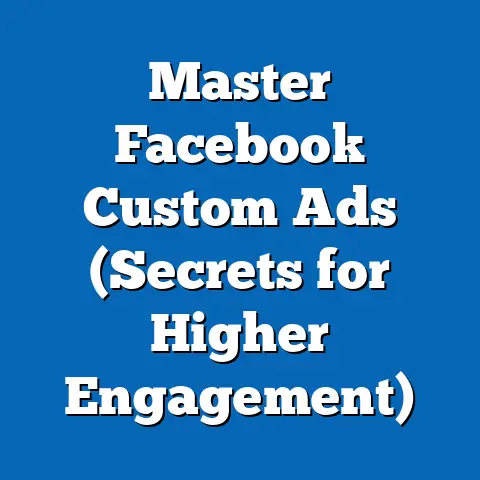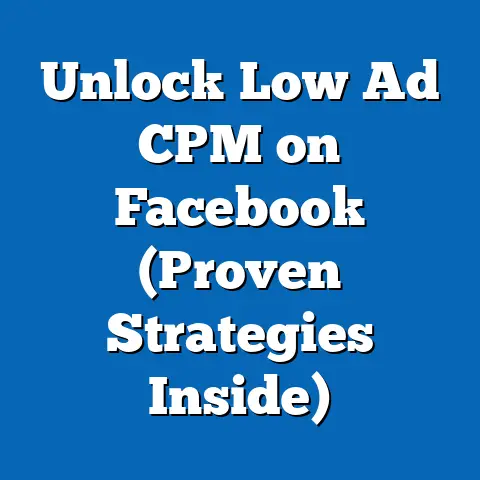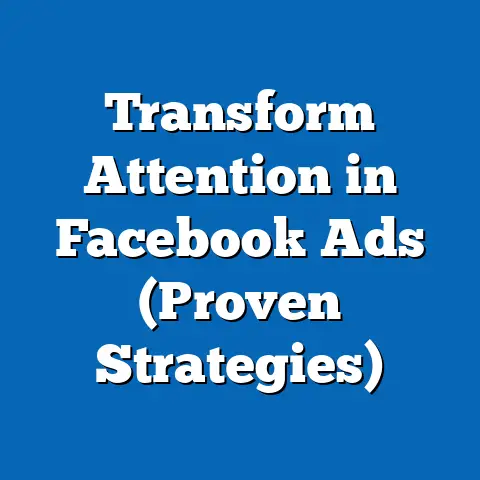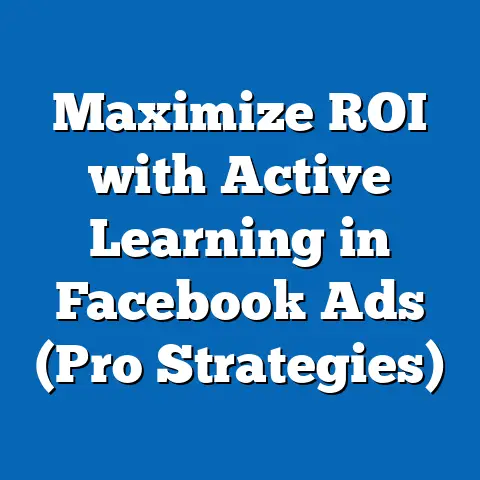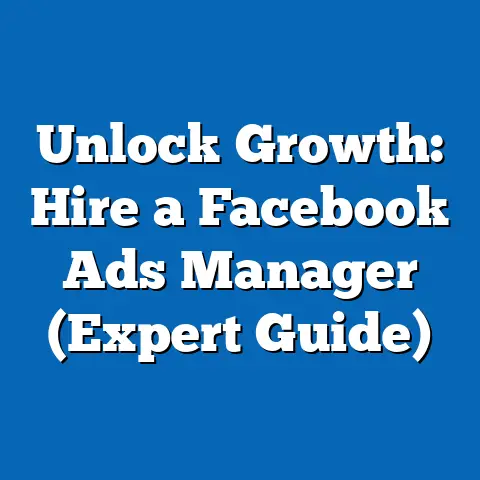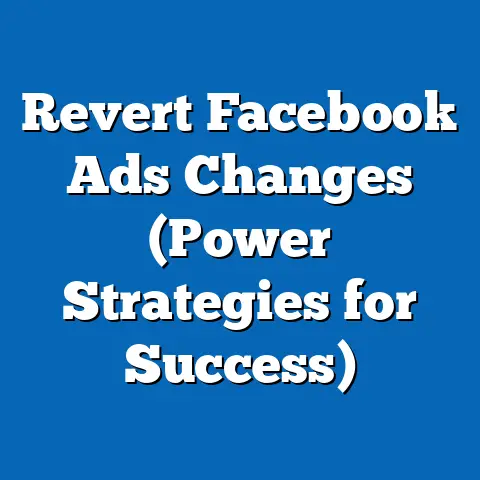Boost Boot Ads on Facebook (Expert Strategies Inside)
The world of digital marketing is a constantly shifting landscape. New platforms emerge, algorithms change, and trends come and go with dizzying speed. But amidst all this flux, some things remain constant: the need to connect with your audience in a meaningful way, the power of a compelling message, and the enduring value of Facebook as a platform for reaching billions of people.
I’ve seen countless businesses struggle to keep up with the latest marketing fads, chasing fleeting trends instead of focusing on solid, proven strategies. That’s why I’m excited to dive into the world of “Boost Boot Ads” on Facebook. These aren’t just another shiny new object; they’re a powerful tool for maximizing visibility, driving engagement, and ultimately, achieving your business goals.
Think of Boost Boot Ads as a turbocharger for your best content. They take your already engaging posts and amplify their reach, putting them in front of a wider audience and sparking conversations. But simply hitting the “Boost Post” button isn’t enough. To truly harness the power of Boost Boot Ads, you need a strategic approach, a deep understanding of your audience, and a commitment to continuous optimization.
Understanding Boost Boot Ads
So, what exactly are Boost Boot Ads, and how do they differ from traditional Facebook ads you might create through Ads Manager? At their core, Boost Boot Ads are simply existing Facebook posts that you pay to promote. You’ve likely seen the “Boost Post” button underneath your own posts and posts from other pages you follow. Clicking that button opens a simplified ad creation process, allowing you to quickly expand the reach of that specific piece of content.
The key difference lies in the complexity and targeting options. Traditional Facebook ads, created within Ads Manager, offer a far greater degree of control over targeting, ad formats, bidding strategies, and creative customization. You can build highly specific audiences, design sophisticated ad campaigns with multiple ad sets and variations, and track a wider range of metrics.
Boost Boot Ads, on the other hand, are designed for speed and simplicity. They’re perfect for quickly amplifying a post that’s already performing well organically or for reaching a broader audience with a time-sensitive message.
Think of it this way: Traditional Facebook ads are like building a custom race car, meticulously designed for optimal performance. Boost Boot Ads are like adding a turbocharger to your existing car – a quick and easy way to boost its power and speed.
Here’s a breakdown of the mechanics:
- Choose a Post: Select an existing post from your Facebook page that you want to promote.
- Set Your Audience: Define your target audience based on demographics, interests, behaviors, or custom audiences.
- Set Your Budget and Duration: Choose how much you want to spend and how long you want the ad to run.
- Select Placement: Decide where you want your ad to appear (Facebook feed, Instagram feed, etc.).
- Review and Publish: Double-check your settings and launch your boosted post.
Why are Boost Boot Ads appealing to marketers?
- Ease of Use: The simplified ad creation process makes them accessible to everyone, regardless of their marketing expertise.
- Speed and Efficiency: You can launch a campaign in minutes, making them ideal for time-sensitive promotions or urgent announcements.
- Organic Look and Feel: Because they’re based on existing posts, they blend seamlessly into the Facebook feed, often resulting in higher engagement rates.
- Cost-Effectiveness: With careful targeting and budgeting, you can achieve significant reach and engagement without breaking the bank.
What types of content benefit from boosting?
- High-Performing Organic Posts: If a post is already generating a lot of likes, comments, and shares organically, boosting it can amplify its reach and engagement even further. I’ve personally seen posts with a strong organic start achieve incredible results when boosted.
- Time-Sensitive Promotions: Boost Boot Ads are perfect for promoting limited-time offers, events, or product launches.
- Announcements and Updates: Use them to share important news, updates, or announcements with your audience.
- Blog Posts and Articles: Drive traffic to your website by boosting posts that link to your latest blog content.
- Video Content: Video is incredibly engaging on Facebook, and boosting your videos can significantly increase their viewership.
When should you consider using Boost Boot Ads?
- When you want to quickly amplify a successful organic post.
- When you need to promote a time-sensitive offer or event.
- When you’re short on time and need a quick and easy ad solution.
- When you want to reach a broader audience with a specific message.
- When you’re on a tight budget and need a cost-effective advertising solution.
Takeaway: Boost Boot Ads are a powerful tool for quickly amplifying your Facebook content and reaching a wider audience. They’re easy to use, cost-effective, and can deliver impressive results when used strategically. Next, let’s explore how to craft compelling ad content that grabs attention and drives engagement.
Crafting Compelling Ad Content
The most brilliant targeting strategy in the world won’t save you if your ad content is boring, irrelevant, or poorly executed. In the crowded and noisy Facebook feed, you have mere seconds to capture someone’s attention and convince them to stop scrolling. That’s why crafting compelling ad content is absolutely crucial for success with Boost Boot Ads.
Here are some expert tips for creating engaging visuals and copy:
- Visuals are King: In a visually driven platform like Facebook, your ad’s visuals are often the first thing people see. Use high-quality images or videos that are relevant to your message and visually appealing. Avoid generic stock photos and opt for authentic images that showcase your brand’s personality.
- Keep it Concise: People are bombarded with information on Facebook, so keep your ad copy short, sweet, and to the point. Get straight to the value proposition and avoid unnecessary jargon or fluff.
- Highlight the Benefits: Focus on the benefits of your product or service, not just the features. Explain how it will solve a problem, improve their lives, or make them feel good.
- Use Strong Verbs: Use action-oriented verbs that encourage people to take action. Examples include “Shop Now,” “Learn More,” “Sign Up,” and “Get Started.”
- Ask Questions: Posing a question in your ad copy can pique people’s curiosity and encourage them to engage with your post.
- Create a Sense of Urgency: Use phrases like “Limited Time Offer,” “Sale Ends Soon,” or “While Supplies Last” to create a sense of urgency and encourage people to act quickly.
- Mobile-First Mindset: Remember that most Facebook users are on mobile devices. Make sure your visuals and copy are optimized for smaller screens.
The Power of Storytelling and Emotional Engagement:
People connect with stories on a deeper level than they do with facts and figures. Incorporating storytelling into your ad content can be a powerful way to capture attention, build trust, and create an emotional connection with your audience.
I’ve seen countless campaigns that leveraged the power of storytelling to achieve incredible results. One example that sticks out is a local bakery that boosted a post featuring the story of how their family business started and the passion they put into every loaf of bread. The post resonated deeply with the community, resulting in a surge of new customers and a significant increase in sales.
Here are some tips for incorporating storytelling into your Boost Boot Ads:
- Share Your Brand’s Story: Tell the story of how your business started, what motivates you, and what makes you unique.
- Showcase Customer Success Stories: Feature testimonials or case studies from satisfied customers.
- Focus on the Human Element: Highlight the people behind your brand and the impact you’re making on the world.
- Use Emotionally Evocative Language: Use words that create a sense of empathy, excitement, or nostalgia.
Best Practices for Headlines, Image Selection, and Call-to-Action Buttons:
- Headlines: Your headline is the first thing people will read, so make it count. Keep it short, attention-grabbing, and relevant to your target audience. Use strong keywords and highlight the key benefit of your offer.
- Image Selection: Choose high-quality images that are visually appealing and relevant to your message. Avoid blurry or pixelated images. Use images that feature people using your product or service in a positive way.
- Call-to-Action Buttons: Your call-to-action button should be clear, concise, and action-oriented. Use a button that aligns with your campaign goals, such as “Shop Now,” “Learn More,” “Sign Up,” or “Contact Us.”
Examples of Successful Boost Boot Ads:
- A local restaurant boosting a post featuring a mouthwatering photo of their signature dish with a call to action to “Order Online.” This ad leverages the power of visual appeal and convenience to drive online orders.
- A clothing boutique boosting a post showcasing a new collection with a call to action to “Shop Now” and a limited-time discount code. This ad creates a sense of urgency and encourages immediate purchases.
- A non-profit organization boosting a post sharing a heartwarming story about how their work is making a difference in the community with a call to action to “Donate Now.” This ad leverages the power of emotional engagement to drive donations.
Takeaway: Crafting compelling ad content is essential for success with Boost Boot Ads. Focus on creating visually appealing, concise, and benefit-driven content that resonates with your target audience. Leverage the power of storytelling and emotional engagement to build trust and drive conversions. Next, we’ll dive into the art of targeting the right audience.
Targeting the Right Audience
You could have the most beautifully crafted ad in the world, but if it’s shown to the wrong people, it’s like shouting into the void. Targeting the right audience is absolutely critical for maximizing the effectiveness of your Boost Boot Ads.
Fortunately, Facebook offers a wealth of targeting options that allow you to reach highly specific groups of people based on their demographics, interests, behaviors, and connections.
Here’s a breakdown of the key targeting options:
- Demographics: Target people based on age, gender, location, education, relationship status, and other demographic factors.
- Interests: Target people based on their interests, hobbies, and passions. Facebook gathers this information from the pages people like, the groups they join, and the content they engage with.
- Behaviors: Target people based on their online and offline behaviors, such as their purchase history, travel habits, and device usage.
- Connections: Target people who are connected to your Facebook page, such as fans, friends of fans, or people who have engaged with your content in the past.
The Importance of Custom Audiences and Lookalike Audiences:
While Facebook’s standard targeting options are powerful, custom audiences and lookalike audiences take your targeting to the next level.
- Custom Audiences: Custom audiences allow you to upload your own customer data (such as email addresses or phone numbers) to Facebook and target those specific individuals. This is incredibly useful for retargeting existing customers or reaching people who have already expressed interest in your brand.
- Lookalike Audiences: Lookalike audiences allow you to create new audiences that are similar to your existing customers or website visitors. Facebook analyzes the characteristics of your source audience and finds other people who share those same traits.
I’ve personally seen lookalike audiences outperform standard targeting options by a significant margin. By leveraging the power of Facebook’s algorithm to find people who are likely to be interested in your products or services, you can dramatically improve your ad performance.
Strategies for Refining Audience Segments:
- Start Broad, Then Narrow Down: Begin by targeting a broad audience based on demographics and interests, then gradually narrow down your targeting based on ad performance data.
- Use A/B Testing: Test different audience segments against each other to see which ones perform best.
- Analyze Your Website Traffic: Use Google Analytics to identify the demographics, interests, and behaviors of your website visitors, then use that information to refine your Facebook targeting.
- Monitor Your Ad Performance: Pay close attention to your ad metrics, such as engagement rates, click-through rates, and conversion rates, to identify which audience segments are most responsive to your ads.
Case Studies of Successful Targeted Boost Boot Ads:
- A local gym targeting people who are interested in fitness, health, and wellness, and who live within a 5-mile radius of the gym. This targeted approach ensures that the ads are shown to people who are most likely to be interested in joining the gym.
- An e-commerce store targeting people who have visited their website in the past 30 days with a custom audience. This retargeting strategy reminds potential customers about the products they viewed and encourages them to complete their purchase.
- A real estate agent creating a lookalike audience based on their existing client base. This strategy allows them to reach new potential clients who share similar characteristics with their successful clients.
Takeaway: Targeting the right audience is crucial for maximizing the effectiveness of your Boost Boot Ads. Leverage Facebook’s powerful targeting options, including custom audiences and lookalike audiences, to reach highly specific groups of people who are likely to be interested in your products or services. Continuously refine your audience segments based on ad performance data to optimize your results. Next, we’ll discuss how to set a budget and choose the right bidding strategy for your Boost Boot Ads.
Budgeting and Bidding Strategies
Even with compelling content and laser-focused targeting, your Boost Boot Ads won’t reach their full potential without a smart budget and bidding strategy. Understanding how to allocate your resources effectively is key to maximizing your ROI.
Setting an Appropriate Budget:
There’s no one-size-fits-all answer to how much you should spend on Boost Boot Ads. The ideal budget depends on a variety of factors, including:
- Your Business Goals: What are you trying to achieve with your ads? Are you looking to increase brand awareness, drive website traffic, generate leads, or make sales?
- Your Target Audience: How large is your target audience? The larger your audience, the more you’ll need to spend to reach a significant portion of them.
- Your Industry: Some industries are more competitive than others, which can impact the cost of advertising.
- Your Ad Relevance Score: Facebook rewards ads that are relevant to their target audience with lower costs and higher reach.
- Your Bidding Strategy: The bidding strategy you choose will also impact your ad spend.
Here are some general guidelines for setting a budget:
- Start Small and Scale Up: Begin with a small budget and gradually increase it as you see positive results.
- Set a Daily Budget: A daily budget allows you to control how much you spend each day.
- Set a Lifetime Budget: A lifetime budget allows you to control how much you spend over the entire duration of your campaign.
- Consider Your Customer Lifetime Value: If you know the average lifetime value of a customer, you can use that information to determine how much you’re willing to spend to acquire a new customer.
Understanding Bidding Strategies:
Facebook offers a variety of bidding strategies that allow you to optimize your ad spend based on your campaign goals.
- Lowest Cost: This bidding strategy aims to get you the most results for your budget. Facebook will automatically adjust your bids to maximize your reach and engagement.
- Cost Per Result Goal: This bidding strategy allows you to set a target cost per result (e.g., cost per click, cost per lead, cost per purchase). Facebook will then adjust your bids to try to achieve your target cost.
- Manual Bidding: This bidding strategy gives you complete control over your bids. You can set your own bids for each ad set and adjust them manually based on performance data.
Choosing the Right Bidding Strategy:
- If you’re new to Facebook advertising, start with the Lowest Cost bidding strategy. This is the easiest and most hands-off option.
- If you have a specific cost per result goal in mind, use the Cost Per Result Goal bidding strategy. This allows you to optimize your ads for a specific outcome.
- If you’re an experienced advertiser and want complete control over your bids, use the Manual Bidding strategy. This requires more time and effort, but it can be effective if you know what you’re doing.
Maximizing ROI with a Limited Budget:
Small businesses often have limited advertising budgets, so it’s important to make every dollar count. Here are some tips for maximizing your ROI with a limited budget:
- Focus on Highly Targeted Audiences: The more targeted your audience, the more likely you are to reach people who are interested in your products or services.
- Create Compelling Ad Content: High-quality ad content will generate more engagement and drive more conversions.
- A/B Test Everything: Test different ad creatives, targeting options, and bidding strategies to see what works best.
- Monitor Your Ad Performance Closely: Pay attention to your ad metrics and make adjustments as needed.
- Consider Using Retargeting: Retargeting allows you to reach people who have already expressed interest in your brand, which can be a very cost-effective way to drive conversions.
Takeaway: Setting an appropriate budget and choosing the right bidding strategy are essential for maximizing the ROI of your Boost Boot Ads. Consider your business goals, target audience, and industry when setting your budget. Experiment with different bidding strategies to see which one works best for your campaigns. Next, we’ll explore how to analyze and optimize your ad performance for continuous improvement.
Analyzing and Optimizing Ad Performance
Launching your Boost Boot Ads is just the first step. To truly maximize your results, you need to continuously analyze your ad performance and make data-driven decisions to refine your strategies.
Key Performance Metrics to Track:
Facebook provides a wealth of data about your ad performance, but it’s important to focus on the metrics that are most relevant to your business goals. Here are some key performance metrics to track for Boost Boot Ads:
- Reach: The number of unique people who saw your ad.
- Impressions: The number of times your ad was displayed.
- Engagement Rate: The percentage of people who engaged with your ad (e.g., liked, commented, shared, clicked).
- Click-Through Rate (CTR): The percentage of people who clicked on your ad after seeing it.
- Cost Per Click (CPC): The average cost you paid for each click on your ad.
- Conversion Rate: The percentage of people who completed a desired action after clicking on your ad (e.g., made a purchase, signed up for a newsletter, filled out a form).
- Cost Per Acquisition (CPA): The average cost you paid for each conversion.
- Return on Ad Spend (ROAS): The amount of revenue you generated for every dollar you spent on advertising.
The Importance of A/B Testing:
A/B testing is a powerful technique for comparing different versions of your ads to see which one performs best. By testing different headlines, images, call-to-action buttons, and targeting options, you can identify the elements that resonate most with your audience and optimize your ads for maximum impact.
Here’s how to implement A/B testing effectively:
- Test One Element at a Time: To get accurate results, only test one element at a time. For example, test two different headlines with the same image and targeting options.
- Use a Control Group: Create a control group that doesn’t see any ads. This will allow you to measure the incremental impact of your ads.
- Run Your Tests for a Sufficient Period: Allow your tests to run for a sufficient period (at least a week) to gather enough data to draw statistically significant conclusions.
- Analyze Your Results: Use Facebook’s analytics tools to analyze your results and identify the winning version of your ad.
- Implement Your Findings: Implement your findings by using the winning version of your ad in your future campaigns.
Expert Advice on Interpreting Analytics:
Interpreting analytics can be challenging, but it’s essential for making data-driven decisions. Here are some tips for interpreting your Facebook ad analytics:
- Look for Trends, Not Just Individual Data Points: Don’t get too hung up on individual data points. Look for trends over time to get a better understanding of your ad performance.
- Compare Your Results to Your Benchmarks: Compare your results to your industry benchmarks to see how you’re performing relative to your competitors.
- Consider the Context: Consider the context of your results. For example, a low click-through rate might be acceptable if you’re targeting a very niche audience.
- Don’t Be Afraid to Experiment: Don’t be afraid to experiment with different ad creatives, targeting options, and bidding strategies. The only way to find out what works best is to try new things.
Making Data-Driven Decisions:
- If your ads have a low engagement rate, try changing your ad creative or targeting options.
- If your ads have a low click-through rate, try improving your headlines or call-to-action buttons.
- If your ads have a low conversion rate, try improving your landing page or simplifying the purchase process.
- If your ads are too expensive, try narrowing down your targeting options or using a different bidding strategy.
Takeaway: Analyzing and optimizing your ad performance is crucial for maximizing the ROI of your Boost Boot Ads. Track key performance metrics, implement A/B testing effectively, and make data-driven decisions to refine your strategies. Continuous improvement is the key to long-term success with Facebook advertising.
Conclusion
As we’ve explored, the world of digital marketing may be ever-changing, but the core principles of effective advertising remain timeless. Connecting with your audience, crafting a compelling message, and delivering value are the foundations of any successful marketing campaign.
Boost Boot Ads on Facebook offer a powerful and accessible way to amplify your best content, reach a wider audience, and achieve your business goals. By following the expert strategies outlined in this guide, you can harness the full potential of these ads and elevate your Facebook marketing efforts to new heights.
Remember to:
- Understand the unique benefits and limitations of Boost Boot Ads compared to traditional Facebook ads.
- Craft compelling ad content that captures attention, builds trust, and drives conversions.
- Target the right audience using Facebook’s powerful targeting options, including custom audiences and lookalike audiences.
- Set an appropriate budget and choose the right bidding strategy to maximize your ROI.
- Continuously analyze your ad performance and make data-driven decisions to refine your strategies.
Don’t be afraid to experiment, test new ideas, and learn from your mistakes. The world of Facebook advertising is constantly evolving, so it’s important to stay curious and adapt to new trends and best practices.
I encourage you to embark on your Facebook advertising journey with renewed confidence and a strategic mindset. By implementing the strategies discussed in this guide, you can unlock the power of Boost Boot Ads and achieve remarkable results for your business. Now go out there and make some magic happen!

